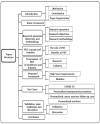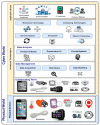Personal Digital Twin: A Close Look into the Present and a Step towards the Future of Personalised Healthcare Industry
- PMID: 35957477
- PMCID: PMC9371419
- DOI: 10.3390/s22155918
Personal Digital Twin: A Close Look into the Present and a Step towards the Future of Personalised Healthcare Industry
Abstract
Digital twins (DTs) play a vital role in revolutionising the healthcare industry, leading to more personalised, intelligent, and proactive healthcare. With the evolution of personalised healthcare, there is a significant need to represent a virtual replica for individuals to provide the right type of care in the right way and at the right time. Therefore, in this paper, we surveyed the concept of a personal digital twin (PDT) as an enhanced version of the DT with actionable insight capabilities. In particular, PDT can bring value to patients by enabling more accurate decision making and proper treatment selection and optimisation. Then, we explored the progression of PDT as a revolutionary technology in healthcare research and industry. However, although several research works have been performed for smart healthcare using DT, PDT is still at an early stage. Consequently, we believe that this work can be a step towards smart personalised healthcare industry by guiding the design of industrial personalised healthcare systems. Accordingly, we introduced a reference framework that empowers smart personalised healthcare using PDTs by bringing together existing advanced technologies (i.e., DT, blockchain, and AI). Then, we described some selected use cases, including the mitigation of COVID-19 contagion, COVID-19 survivor follow-up care, personalised COVID-19 medicine, personalised osteoporosis prevention, personalised cancer survivor follow-up care, and personalised nutrition. Finally, we identified further challenges to pave the PDT paradigm toward the smart personalised healthcare industry.
Keywords: COVID-19; data analysis; digital twin; personal digital twin; personalised healthcare.
Conflict of interest statement
The authors declare no conflict of interest.
Figures













Similar articles
-
Adversarial Examples on XAI-Enabled DT for Smart Healthcare Systems.Sensors (Basel). 2024 Oct 27;24(21):6891. doi: 10.3390/s24216891. Sensors (Basel). 2024. PMID: 39517788 Free PMC article. Review.
-
Blockchain-Based Digital Twins Collaboration for Smart Pandemic Alerting: Decentralized COVID-19 Pandemic Alerting Use Case.Comput Intell Neurosci. 2022 Jan 13;2022:7786441. doi: 10.1155/2022/7786441. eCollection 2022. Comput Intell Neurosci. 2022. PMID: 35035466 Free PMC article.
-
The impact of digital twins on the evolution of intelligent manufacturing and Industry 4.0.Adv Comput Intell. 2023;3(3):11. doi: 10.1007/s43674-023-00058-y. Epub 2023 Jun 7. Adv Comput Intell. 2023. PMID: 37305021 Free PMC article.
-
Digital Twins in Healthcare: An Architectural Proposal and Its Application in a Social Distancing Case Study.IEEE J Biomed Health Inform. 2023 Oct;27(10):5143-5154. doi: 10.1109/JBHI.2022.3205506. Epub 2023 Oct 5. IEEE J Biomed Health Inform. 2023. PMID: 36083955 Review.
-
Blockchain-secure patient Digital Twin in healthcare using smart contracts.PLoS One. 2024 Feb 29;19(2):e0286120. doi: 10.1371/journal.pone.0286120. eCollection 2024. PLoS One. 2024. PMID: 38422025 Free PMC article.
Cited by
-
Medical Digital Twin: A Review on Technical Principles and Clinical Applications.J Clin Med. 2025 Jan 7;14(2):324. doi: 10.3390/jcm14020324. J Clin Med. 2025. PMID: 39860329 Free PMC article. Review.
-
Envisioning the Future of Personalized Medicine: Role and Realities of Digital Twins.J Med Internet Res. 2024 May 13;26:e50204. doi: 10.2196/50204. J Med Internet Res. 2024. PMID: 38739913 Free PMC article.
-
Predictors for adherent behavior in the COVID-19 pandemic: A cross-sectional telephone survey.Front Public Health. 2022 Oct 20;10:894128. doi: 10.3389/fpubh.2022.894128. eCollection 2022. Front Public Health. 2022. PMID: 36339221 Free PMC article.
-
Biospecimen Digital Twins: Moving from a "High Quality" to a "Fit-for-Purpose" Concept in the Era of Omics Sciences.Cancer Genomics Proteomics. 2023 May-Jun;20(3):211-221. doi: 10.21873/cgp.20376. Cancer Genomics Proteomics. 2023. PMID: 37093689 Free PMC article. Review.
-
Digital Twins Use in Plastic Surgery: A Systematic Review.J Clin Med. 2024 Dec 23;13(24):7861. doi: 10.3390/jcm13247861. J Clin Med. 2024. PMID: 39768784 Free PMC article. Review.
References
-
- Rosen R., Von Wichert G., Lo G., Bettenhausen K.D. About the importance of autonomy and digital twins for the future of manufacturing. IFAC-PapersOnLine. 2015;48:567–572. doi: 10.1016/j.ifacol.2015.06.141. - DOI
-
- Fuller A., Fan Z., Day C., Barlow C. Digital Twin: Enabling Technologies, Challenges and Open Research. IEEE Access. 2020;8:108952–108971. doi: 10.1109/ACCESS.2020.2998358. - DOI
-
- Ringsquandl M., Lamparter S., Lepratti R., Kröger P. Knowledge Fusion of Manufacturing Operations Data Using Representation Learning; Proceedings of the IFIP International Conference on Advances in Production Management Systems; Hamburg, Germany. 3–7 September 2017; pp. 302–310.
-
- Sahal R., Alsamhi S.H., Breslin J.G., Brown K.N., Ali M.I. Digital Twins Collaboration for Automatic Erratic Operational Data Detection in Industry 4.0. Appl. Sci. 2021;11:3186. doi: 10.3390/app11073186. - DOI
-
- El Saddik A., Badawi H., Velazquez R.A.M., Laamarti F., Diaz R.G., Bagaria N., Arteaga-Falconi J.S. Dtwins: A digital twins ecosystem for health and well-being. IEEE COMSOC MMTC Commun. Front. 2019;14:39–43.
MeSH terms
Grants and funding
LinkOut - more resources
Full Text Sources
Medical

